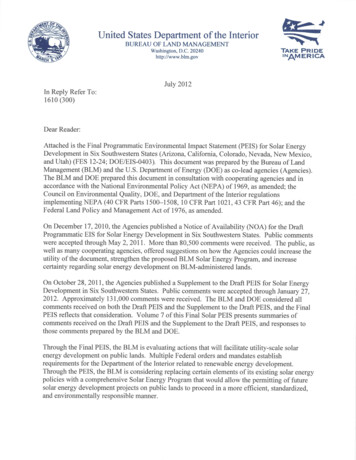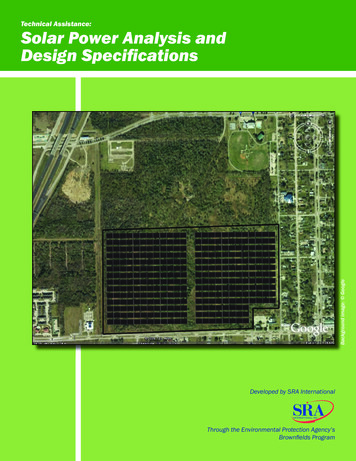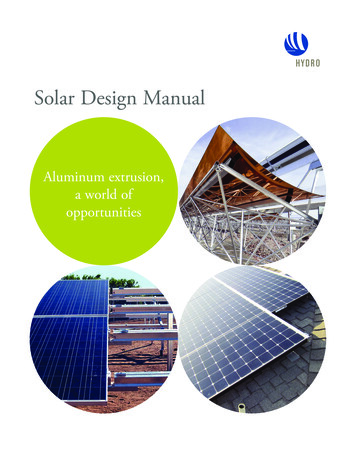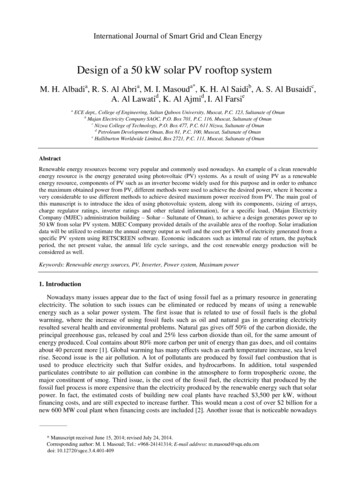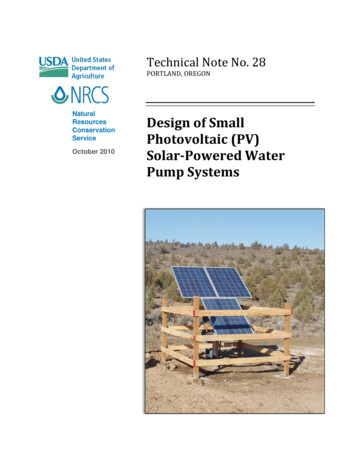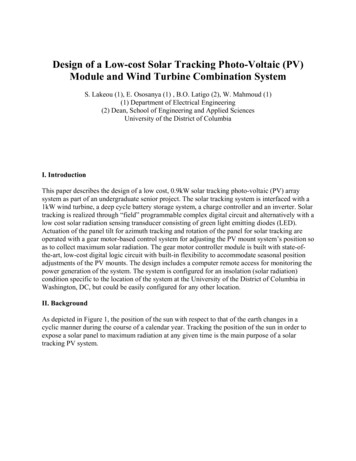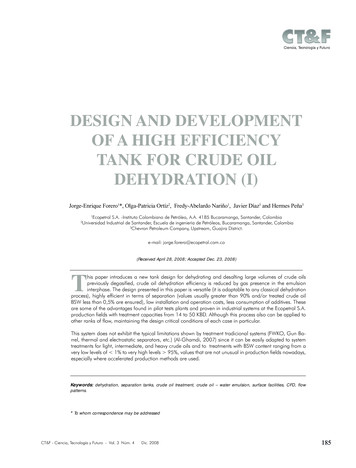
Transcription
DESIGN AND DEVELOPMENT OFSOLAR PANEL CLEANING SYSTEMA project thesis for the fulfilment of therequirements for the award of the degree ofBachelor of TechnologyinMechanical EngineeringandMaster of TechnologyinMechatronics and AutomationbySHAIKH TARIQ MOBINROLL NO – 710ME4085Under the Supervision ofProf Subrata Kumar PandaDEPARTMENT OF MECHANICAL ENGINEERINGNATIONAL INSTITUTE OF TECHNOLOGYROURKELA-769008, ODISHA (INDIA)
DECLARATIONI hereby declare that to the best of my knowledge this submission is my own work and that itcontains no material previously published or written by another person nor materialwhich to a substantial extent has been accepted for the award of any other degree or ning,exceptwhereacknowledgement has been made in the text.Date: 1st June, 2015Shaikh Tariq MobinNIT Rourkelaiidue
NATIONAL INSTITUTE OF TECHNOLOGY,ROURKELACERTIFICATEThis is to certify that the project entitled “Design and Development ofSolar Panel Cleaning System”, being submitted by Shaikh Tariq Mobinbearing Roll No – 710me4085, has been carried out under my supervision forthe purpose of fulfilment of the requirements for the degree of Bachelor ofTechnology in Mechanical Engineering and Master of Technology inMechatronics and Automation during the session 2014-2015 in theDepartment of Mechanical Engineering, National Institute of Technology,Rourkela.To the best of my knowledge, this work has not been submitted to anyother University/Institute for the award of any degree or diploma.PLACE: ROURKELADATE: 30TH MAY, 2015(PROF. SUBRATA KUMAR PANDA)DEPARTMENT OF MECHANICAL ENGINEERINGNIT ROURKELAiii
ACKNOWLEDGEMENTThis report a result my efforts of my project work for the fulfilment of the requirements ofDual Degree : B.Tech in Mechanical Engineering and M.Tech in Mechatronics andAutomation in the Department of Mechanical Engineering, NIT Rourkela. This projectwould not have been possible without the active support and help by various people, whome Iwish to express my sincere gratitude.I would first of all like to express my sincere thanks and gratitude to my mentor andsupervisor Prof. Subrata Kumar Panda who has been the constant driving force behind thisproject. He provided me a liberal environment and gave me the required freedom to carry outmy project in an independent way. His inclination for incubating new ideas and deliver thesolution were always important sources of inspiration and motivation for me.I am also very much thankful to my fellow classmates Ashish Singh, Chiranjibi Sahoo,Abyarth Kumar Behera and Sheak Aftab Ali for constant support and suggestion in the entireprocess.Lastly, I would also like to thank my parents who were always behind me for the moralsupport I required in this project.iv
ABSTARCTSolar energy is the most abundant source of energy for all the forms of life on the planetEarth. It is also the basic source for all the sources of energy except Nuclear Energy. But thesolar technology has not matured to the extent of the conventional sources of energy. It faceslots of challenges such as high cost, erratic and unpredictable in nature, need for storage andlow efficiency. This project aims at increasing the efficiency of solar power plants by solvingthe problem of accumulation of dust on the surface of solar panel which leads to reduction inplant output and overall plant efficiency. It proposes to develop a Solar Panel CleaningSystem which could remove the accumulated dust on its surface on a regular basis andmaintain the solar power plant output. The system is a robotic system which could moveautonomously on the surface of solar panels by using pneumatic suction cups and use drymethods for cleaning such as rotating cylindrical brush and vacuum cleaning system keepingin mind the limited availability of water in areas where such plants are mainly located. Thisproject also aims to reduce the human involvement in the process of solar panel cleaning as itis a very hazardous environment for them in scorching sun.v
CONTENTSDeclaration . iCertificate .iiAcknowledgement .iiiAbstract . .ivList of Figures .viList of tables .viiIntroduction . 1Autonomous Robot . 1Cleaning Robot . 1Literature Review . 3Removal of dust by Mechanical Method . 3Removal of Dust using nano-film . 4Super-Hydrophylic Material . 4Super-Hydrophobic Material . 4Removal of Dust by Electrostatic Method . 5Key Problem . 7Methodology . 9Locomotion Unit . 9Cleaning Unit . 10Linear Actuator . 10Brush . 11Working Principle . 12Design and Component Specification . 13Locomotion Unit . 13Double Rack and Pinion. 14Pneumatic System . 14Structure . 15Cleaning Unit . 16Linear Actuator . 16Linear Actuator Platform . 16V – Wheel Assembly. 17DC Motor . 17Vacuum Pump . 18Electronics . 19vi
Weight Estimation . 20Analysis and Calculation . 21Static Analysis of Gear . 21Conclusion . 26References . 27vii
List of FiguresFigure 1 Basic Structure of Electric Curtain . 5Figure 2 Single Phase Electric Curtain . 5Figure 3 Three Phase Electric Curtain . 6Figure 4: Monthly average maximum power output . 7Figure 5 Working of Doube Rack and Pinion System . 9Figure 6 Working of Prototype . 12Figure 7 Locomotion Unit . 13Figure 8 Double Rack and Pinion Arrangement . 14Figure 9 Pneu8matic System . 14Figure 10 Structure of the Legs . 15Figure 11 Linear Actuator System . 16Figure 12 V - Gantry Plate . 16Figure 13 V - Wheel Assembly. 17Figure 14 DC Motor . 17Figure 15 Vacuum Pump . 18Figure 16 Electronic Component Layout . 19Figure 17 Schematic Diagram of Electronic Circuit . 19Figure 18 Model Information . 21viii
List of TableTable 1 Working of Double Rack and Pinion . 10Table 2 Weight Estimation . 20ix
INTRODUCTIONA robot is a machine equipped with the ability to carry out series of actions automatically onthe basis of input from the environment and inbuilt program.1.1 Autonomous RobotAn autonomous robot has the ability to carry out tasks and commands with high degree ofaccuracy autonomously according to the following rules. Has the ability to gain tangible inputs from the environment. Has the ability to perform task for long intervals without human interferences. Has the ability to move in its workspace without human help. Has the ability to avoid situations that are harmful to itself or humans unless it isprogrammed to do so.1.2 Cleaning RobotCleaning is one of the necessary activity in the daily life of human beings, but in the sametime regarded as one of the least preferred jobs. In some places cleaning also becomeshazardous for humans. So time and again machines have been invented to assist us in thisnecessary evil of cleaning. Robotic cleaning is the most recent trend which is being seen inthe recent years. Robotic cleaner is an autonomous device that can move around and clean thesurface using different techniques such as mopping, vacuum cleaning, or simply scrubbingthe surface with a rotating brush.The proposed solar panel cleaning system falls in the category of cleaning robots, but forindustrial cleaning application in large scale solar power plants. It is an autonomous robotthat moves on the slanted surface of the solar panels with the help of vacuum suction cupsand cleans the surface of the panels with the help of a rotating cylindrical brush. In each cyclethe robot first moves a certain distance in the direction parallel to the base of the solar paneland then the rotating brush moves in the direction perpendicular to the base from top tobottom. Depending upon the latidunial location of the solar power plants the solar panels arefixed at an angle to the ground, so as to re
cleaning the solar panel so that the process can become more reliable and fast, thus increasing the power output of the solar power plant. Various technologies being developed around the world for self-cleaning of solar panels are discussed below: 2.1. Removal of dust using Mechanical Methods There are different types of methods that are used to clean solar panel. Few of them are mechanical .

